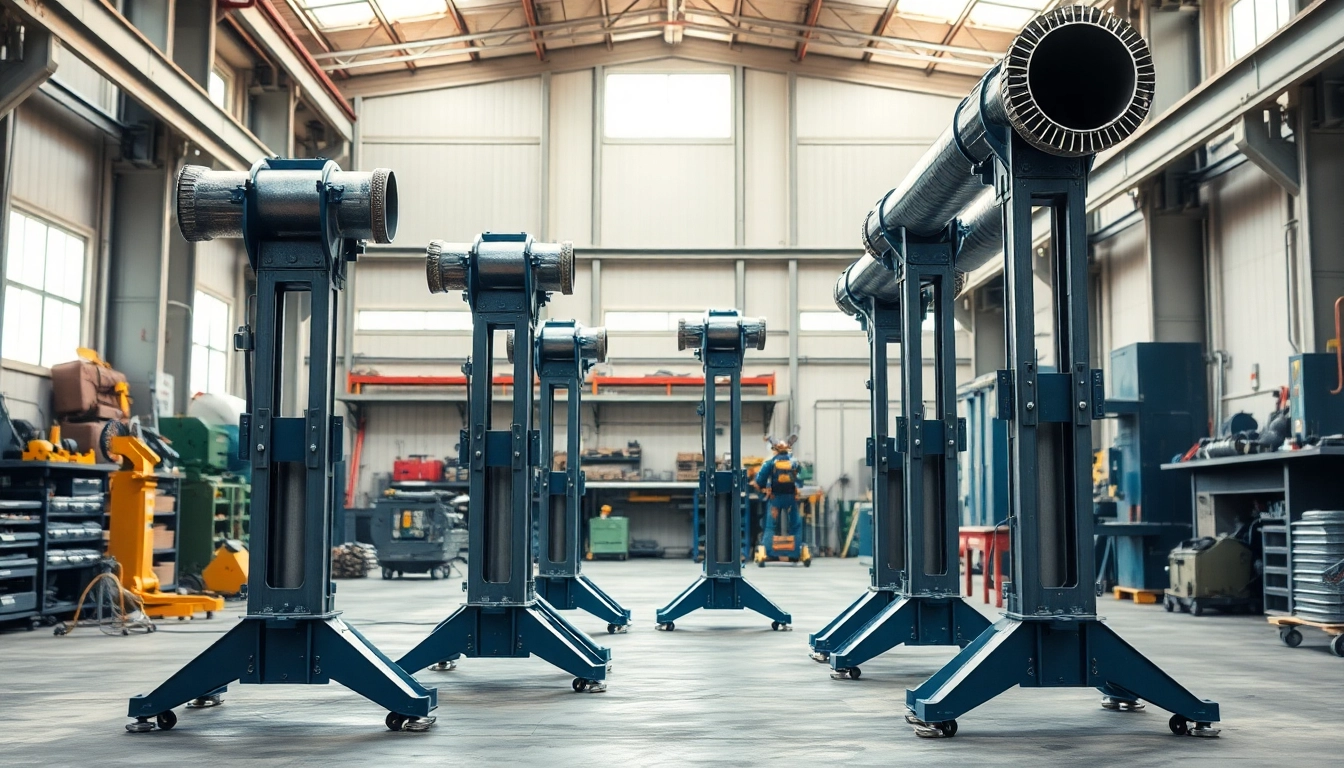
Understanding Pipe Stands: An Introduction
In various industrial applications, efficient pipe handling is critical to ensure quality, safety, and productivity. A fundamental tool that facilitates this process is the pipe stand. This article delves into what pipe stands are, their types, applications, and how to choose the best one for your needs.
What Are Pipe Stands?
Pipe stands are specialized support structures designed to hold and elevate pipes during various assembly or maintenance tasks. They provide stability, allowing for safer and more efficient working conditions, especially in environments where heavy or cumbersome pipes are present. Commonly used in plumbing, welding, and construction projects, pipe stands are essential for workers handling long lengths of pipe and various diameters that require secure positioning during welding, cutting, or fitting.
Types of Pipe Stands Available
Pipe stands come in various forms, each tailored to specific tasks and environments. Here are some commonly found types:
- Fixed Height Pipe Stands: These provide a stable base at a set height, suitable for easier access in tasks that don’t require height adjustability.
- Adjustable Pipe Stands: Designed to accommodate various pipe sizes, these stands allow users to modify their height and adapt to different job requirements.
- Roller Head Pipe Stands:These come equipped with roller heads that facilitate easy rotation of the pipe, making them particularly useful in welding and assembly applications.
- Tripod Pipe Stands: With a three-legged design, these stands offer stability on uneven surfaces, making them ideal for outdoor or varied terrain applications.
- Heavy-Duty Pipe Stands: Built for strength, these stands can support extremely heavy pipes, often used in industrial settings.
Common Applications of Pipe Stands
Pipe stands find applications across different sectors, including:
- Welding: Pipe stands provide stable support during welding, ensuring a secure setup that maintains accuracy during the welding process.
- Plumbing: In plumbing installations, pipe stands help align pipes for welding or gluing, preventing misalignment that could lead to leaks.
- Construction: On construction sites, pipe stands expediently hold pipes in place for structural support before actual installation.
- Maintenance: In maintenance scenarios, such as repair instances where pipes are disconnected, supports facilitate easy access for repair workers.
Key Features of Quality Pipe Stands
When selecting pipe stands, certain features significantly influence their effectiveness and suitability for specific projects:
Load Capacity Considerations
The load capacity of a pipe stand is one of the most critical considerations. Quality stands should be rated to handle the specific weights they will support. For example, if handling large diameter steel pipes, ensure the pipe stand can accommodate the weight while maintaining stability. It is advisable to choose stands with a load capacity that exceeds your expected use by at least 20% to ensure safety and effectiveness.
Adjustability and Height Benefits
Adjustability allows for flexibility across various projects. Choosing a pipe stand that can be modified to different heights provides adaptability in work settings where pipe sizes may vary. This feature is particularly beneficial in welding applications, as it enables workers to position pipes at optimal working heights and angles, reducing strain and improving accessibility.
Material Choices and Durability
Pipe stands are made from various materials, with steel and aluminum being the most common. Steel stands often provide better strength and stability, making them ideal for heavy-duty applications. However, aluminum stands are lighter and easier to transport, making them suitable for mobile operations. Look for stands with protective finishes that resist corrosion and wear, ensuring longevity even in harsh environments.
Choosing the Right Pipe Stand for Your Needs
Making the right choice in pipe stands can significantly impact project efficiency and safety. Consider the following factors in your selection:
Evaluating Project Requirements
Understanding your project’s unique requirements is crucial. For instance, if you are primarily working with smaller pipes in a plumbing application, a lightweight, adjustable stand may suffice. Conversely, in industrial settings where heavy pipes are common, invest in heavy-duty models that can accommodate weight while ensuring stability.
Best Practices for Selection
When selecting pipe stands, some best practices include:
- Assessing the maximum weight and dimensions of the pipes you will support.
- Considering the workspace layout. Ensure the stand design fits well within your operational footprint.
- Reading reviews or seeking recommendations for reputable brands known for quality and durability.
Comparing Top Brands and Models
Not all pipe stands are created equal. Investigating various brands and their offerings can yield significant benefits. Some top brands in the market include:
- Sumner: Known for their robust and versatile designs, Sumner stands are a popular choice among professionals.
- Ridgid: Provides some of the most durable pipe vise and stand offerings, known for their reliability in stressful environments.
- B&B Pipe Tools: Focuses on heavy-duty applications, ensuring their products withstand tough job site conditions.
Using Pipe Stands Safely and Effectively
While pipe stands enhance safety when used correctly, improper handling can lead to accidents. Here’s how to use them safely:
Assembly and Setup Guidelines
Assembling and setting up your pipe stands correctly is essential for ensuring safety and stability. Here are some guidelines to follow:
- Follow the manufacturer’s instructions during assembly, ensuring all components are correctly fitted.
- Check the surface where you plan to position the stands. Ensure it is level and firm to prevent tipping.
- Before placing the pipe on the stand, verify the load capacity and adjust to the appropriate height as needed.
Maintenance Tips for Longevity
Maintaining your pipe stands can extend their life and performance. Consider these maintenance practices:
- Regularly inspect stands for signs of wear and damage, such as rust, bent components, or loose fittings.
- Clean stands after use to remove dirt and debris that may cause corrosion over time.
- Store stands in a protected area when not in use, minimizing exposure to elements that could degrade materials.
Operating Procedures to Ensure Safety
To ensure a safe working environment when using pipe stands, always adhere to the following operating procedures:
- Never exceed the load capacity of the stands.
- Always use personal protective equipment (PPE) when working with heavy materials.
- Train all personnel on proper setup and handling procedures to mitigate risks associated with improper use.
Conclusion: Investing in Quality Pipe Stands
Pipe stands are invaluable tools that serve vital roles in various industries. Investing in quality stands tailored to your project’s needs ensures safety, efficiency, and productivity, making them well worth the expense. Here are key takeaways to remember:
Summary of Benefits
Properly selected and maintained pipe stands provide numerous benefits, including:
- Increased safety for workers handling heavy or awkwardly shaped pipes.
- Reduced strain and fatigue for operators through adequate support.
- Enhanced operational efficiency by providing stable setups for welding, cutting, and assembling tasks.
Cost vs. Value Considerations
While the initial investment in pipe stands may vary widely based on features and brand, consider the long-term value they provide. Quality stands can prevent accidents, reduce equipment damage, and improve productivity, often offsetting any higher upfront costs.
Final Thoughts on Purchasing
In summary, when selecting pipe stands, prioritize quality, load capacity, adjustability, and durability. By adhering to the best practices outlined in this article, you can choose the right pipe stands that will meet your needs safely and efficiently, ultimately enhancing your overall project execution.







